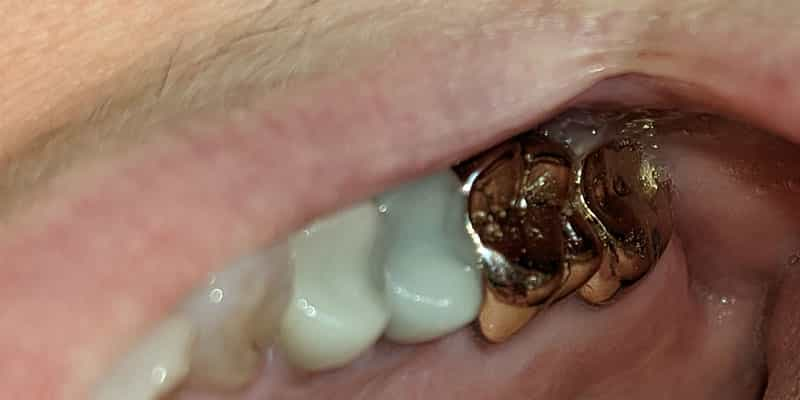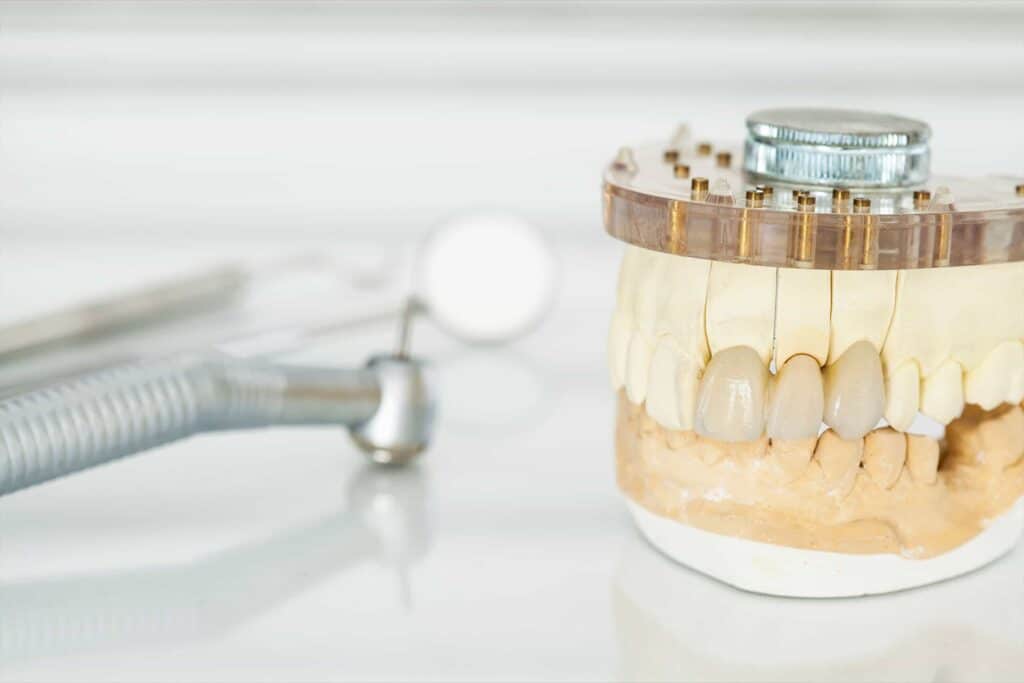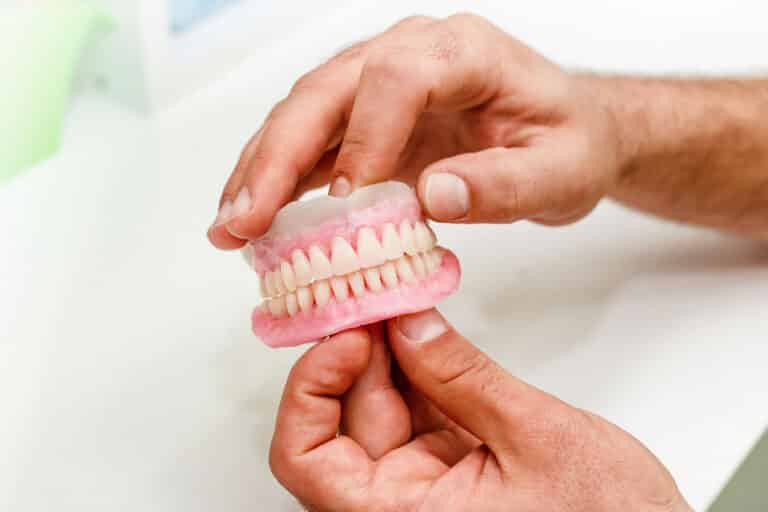Metal crowns are tooth shaped caps that fit over a prepped tooth. They are made up of various types of metals, including gold. Dental crowns as a whole use a few types of materials that are routinely used to fabricate a crown. The two most popular materials are metal alloyA mixture of metals that aims to blend the best properties of each metal. Gold crowns are not 100% gold, but contain other metals such as platinum, palladium, silver, copper or tin. and ceramics. While not as common, resin crowns are also used on occasion.
Metal crowns are dental crowns that are made up of a combination of precious and non precious materials. Most commonly referred to as “gold crowns”, metal crowns are not actually composed exclusively of gold.
Pure gold is too soft and malleable to be an effective dental material. Instead they are made up of various noble and base metals. The percentage of noble metals will determine the type of metal crown.
Once a popular choice, gold is not used as frequently due to a few factors such as esthetics and the rising cost of precious metals. While not as popular, gold crowns are still routinely made due to their long standing history and efficacy.
Are Gold Dental Crowns Better Than Porcelain Crowns?
A very common question, both porcelain crowns and gold dental crowns each have their advantages and disadvantages. Both gold dental crowns and porcelain crown have something they are better at. Personal preferences will typically dictate the types of crowns that that are used to protect the underlying tooth.
Longevity of Metal vs Porcelain Dental Crown
Both materials are excellent to use for a dental crown. Functionally they both are tooth shaped caps that protect the underlying tooth structure from fracture. Both types of crowns can last 10-15 years, however many clinicians have seen that a gold crown can last several decades long. Both types of dental crowns are susceptible to tooth decay, however a gold crown can have better marginal adaptation. This mean the interface between the crown and natural tooth can potentially be so smooth that it’s imperceptible. The smoother the margins, the less that bacteria can accumulate resulting in less tooth decay.
A gold crown will also mimic the wear and tear of a natural tooth better than porcelain crowns. This can be important if there is no dental crown on the opposite arch. However for practical considerations, this is a small aspect to consider when comparing a gold dental crown versus a porcelain dental crown.
Esthetics of Metal vs Porcelain Dental Crown
When it comes to esthetics, there’s no comparison. Porcelain crowns are by in far able to mimic the appearance of a natural tooth better than any type of gold crown. A porcelain crown can be done so well that they cannot be distinguished from the adjacent natural tooth. However this is also difficult to achieve.
The dentist may also have preferences as to which material is better in which situation. Many ‘old school’ dentists prefer to place gold where possible. As the costs of the metals used increases, the prevalence of gold diminishes.

Procedural Differences of Metal vs Porcelain Dental Crowns
The procedure of getting a metal dental crown is going to be staged where a temporary crown is placed at the first appointment and the permanent crown is placed at the second. While this generally done with porcelain crowns as well, with CADCAMAn acronym for ‘computer aided design computer aided milling’. This technology digitally designs and makes crowns out of various, large blocks of porcelain. technology, it is possible to skip the temporary crown and cement the permanent crown on the same visit. As soon as the crown is ready, it can be cemented all without leaving the dental office. This can save time by reducing the trips to a single visit to the dental office.
Allergic Reactions Considerations
While an allergic reaction to porcelain or gold is possible, a true allergic reaction is exceedingly rare. More than likely there is something else causing the response.
Cost Differences Between Gold vs Porcelain Crowns
The cost is going to be very similar across the board. Most often any differences in cost can be attributed to the cost of the material or extra procedures. For example, an anterior esthetic crown with a custom shade may cost more than a gold crown. Usually the cost range will be within a couple hundred dollars between gold and a porcelain crown.
A simple way to consider which material to use, consider using a porcelain crown if there are any esthetic concerns at all. While not as important for back teeth, the front teeth are almost always going to be a white material. The dentist may have a preference for only using porcelain, however know there are more options.
Most Common Metals Used
Today gold dental crowns are made up of a combination of several types of metals. The composition is designed to optimize many properties to have the dental crowns mimic natural tooth and last as long as possible. The most commonly used metals used include:
- Gold
- Silver
- Copper
- Palladium
- Platinum
- Zinc
Types of Metal Crowns
There are a few types of metal crowns with the difference being the composition of the dental crown itself. There is no mainstream crown, whether as a permanent crown or temporary crown, that is made up of a single metal, including stainless steel crowns.
Rather than being made up of only gold, nickel, or chromium, the various types of dental crowns are composed of a combination of metals and then are classified based on that composition.
The composition of metal dental crowns, according to the American Dental Association (ADA) includes:
- High Noble Metal Crowns: Also called precious metal dental crowns, these dental crowns are at least 60% noble metals, of which at least 40% is gold.
- Noble Metal Crowns: Also called semi-precious metal dental crowns, these crowns must contain at least 25% noble metals.
- Base Metal Crowns: Also called non-precious metal crowns, these crowns contain less than 25% noble metals. Sometimes they contain none at all.
Additionally, there are classifications of strength for the various metal crown combinations that indicate where they are best used. According to the International Organization for Standardization (ISO), these alloy types and their suitable dental applications are:
- Type 1: low strength – suitable for low-stress situations, e.g. inlays
- Type 2: medium strength – suitable for moderate stress situations, e.g. inlays and onlays
- Type 3: high strength – suitable for high-stress situations, e.g. onlays, pontics, full dental crown
- Type 4: extra high strength – suitable for very high stress situations, e.g. saddles, bars, claspsSmall extensions on partial dentures, made of plastic or metal, that grab onto natural teeth to increase retention of the partial denture., partial frameworks
What are Stainless Steel Crowns
Stainless steel crowns is a preformed crown, typically made of a combination of nickel, chromium, and iron, that are indicated for pediatric use. Children who have extensive tooth decay and require a crown do not get the same type of crown that adults receive.
These preformed crowns come in various sizes but are not built custom to the tooth like adult crowns are. Often completed in a single visit, an appropriately sized stainless steel crown is selected, formed, and cemented to the prepared tooth.
The chewing capability is sufficient and the wear and tear doesn’t really come into play as the baby tooth usually falls out before becoming an issue. With enough time, the primary teeth exfoliate and the permanent tooth takes its place, not necessitating the fabrication of a custom crown.
Are Stainless Steel Crowns Permanent?
Stainless steel crowns are designed to be temporary in nature since the baby teeth they cover are also temporary. This is due to poor marginal adaptation, as compared to traditional crowns, stainless steel crowns do not seal out bacteria as well.
However, this does not matter as much for pediatric use since the primary teeth typically exfoliate prior to any major problems. It is only when stainless steel crowns are placed on permanent teeth, usually as a last resort type solution, that these problems occur.
It should be noted that with the increased popularity of the ceramic material zirconia, there is a rise in the use of pediatric zirconia crowns. However, stainless steel crowns are still commonly and routinely used in the posterior teeth since metal is more malleable and can be better adapted to the tooth.
Prefabricated zirconia crowns are used more in the anterior teeth due to a good blend between esthetics, efficacy, and cost.
What Are Porcelain Fused to Metal (PFM) Crowns?
Porcelain fused to metal crowns contain both metal and porcelain. This style of dental crown has a metal substrate that has porcelain fused in a jacketing technique. The amount of surface area covered will vary, however, the area that will always be covered in porcelain is the facialThe ‘outside’ surface of the teeth that directly face either the lips or cheeks. or visible side. Porcelain may cover as much as the entire crown, or just the visible surface. The most common area to be metal is the lingual or occlusalThe ‘top’ of teeth where chewing occurs on posterior teeth. This surface has pits and grooves. surface. This strengthens the crown in the areas that will be in daily use.
The main idea behind porcelain fused to metal crowns is to blend the strength of metal with the esthetics of porcelain. The early generations of all ceramic crowns were highly esthetic, however they had a low survival rate. Often they fractured prematurely due to the strains and stresses placed on them during regular daily chewing. By incorporating a metal base under the visible porcelain, the longevity was greatly increased. However over time the porcelain still fractures, exposing the metal substrate.
This propelled porcelain fused to metal crowns into popularity and was used frequently, with only highly esthetic cases using all ceramic crowns. Since ceramic is translucent, an opaque material is used to prevent the metal from showing through.
Without an opaquer, porcelain fused to metal crowns would appear extremely dark and unesthetic. The downside is that now the entire crown is not translucent, resulting in a more monochromatic appearance. This results in PFM not being as esthetic as all ceramic crowns, which still holds true to this day regardless of the type of ceramic crown.
How Popular Are Porcelain Fused to Metal Crowns Today?
Once very popular, they are now being phased out due to the rise of more effective ceramic crowns such as lithium disilicate (Emax) and zirconia crowns. The newer generations of ceramics are just as strong if not stronger than a porcelain fused to metal crown with the added bonus of also being highly esthetic. That being said, there are a few instances where PFM crowns may be indicated where the strength and flexibility of metal are required in a semi-esthetic case.
How Are Metal Crowns Made?
The process of making metal crowns differs significantly from ceramic crowns due to the properties of the materials. Additionally, due to the increased expense of the raw materials, they are not milled in a subtractive manner like modern-day ceramics.
First, an exact replica of the prepped tooth and surrounding teeth and gums is fabricated. This is completed via either a traditional analog impression using polyvinyl siloxane or a digital impression using an intraoral scanner.
Lab Related Work
Once the models have been sent to the lab, a small amount of die spacer is placed onto the model. The die spacer is used to ensure that there is a small amount of space for the cement to fill and adhere the crown to the tooth.
Then a crown is made in wax, often called a ‘wax-up’. The wax-up is essentially a preview of the gold crown and can be changed easily. Once completed, the wax-up perfectly replicates the anatomy, occlusion, and contacts of the previous clinical crown to the prescribing doctor’s preferences. The doctor may ask for different anatomy, variances in occlusion, or interproximal contact.
Once approved, the wax-up is attached to a wax sprue and is placed in a metal cylinder called a casting ring. Then heat-resistant material, typically a gypsum or phosphate-bonded material, is poured into the ring and completely covers the wax. This process is called investing. Once set, the casting ring is placed in a furnace of varying, but extremely high temperatures which burn out the wax leaving a void in the shape of the crown.
Once burned out, metal ingots of a specific alloy composition stated earlier, are placed in a centrifugal casting machine (sometimes called a broken arm casting machine). The ingots are then melted in a crucible and the casting ring is also placed within the centrifugal casting machine. Once released, the machine flings the molten metal into the void within the casting machine, forming the metal crown.
The casting ring is then typically quenched, a process of placing it in cold water which aids in improving the physical properties of the metal, a process called quenching. Additionally quenching aids in the divestment process, which is removing the crown from the previously mentioned investing materials. Once removed and cleaned, the crown may be placed in an acid solution, a process called pickling.
The final steps are called finishing and processing. During this process, the crown is separated from the sprue. Any large irregularities are removed and then the crown’s occlusion, excursive movements, and interproximal contacts are adjusted. The crown is also polished to a high shine. After quality assurance, the crown is disinfected, packaged, and sent to the prescribing dental office.
When Should I Request a Metal Dental Crown vs Another Material?
There will be instances where metal crowns may be better suited than ceramic or resin materials. While this cannot be generically answered due to the uniqueness of every mouth, a good rule of thumb is stronger, less esthetic material in the posterior, and more esthetic, less strong material in the front.
However, blindly following this guideline may not result in the best clinical outcome. Here are some general guidelines for when a metal crown may be a better choice.
Relying on a Tried and True Treatment Option
If a “tried and true” treatment option is most important. Gold crowns have a fantastic history and data supporting its effectiveness as a material for dental crowns. There are individual reports of gold crowns that are still functional after multiple decades of use, sometimes over 50 years.
Zirconia, while a fantastic material, does not have as long of a historical track record as gold. This is not to say that zirconia is not a good material, on the contrary there are a lot of studies and data that support its efficacy.
However more time is needed to be able to compare longitudinal studies which we will find out with time.
When The Opposing Tooth is also Metal
When different materials are in constant contact, there will be a different wear rate. It is generally recommended to have similar materials in occlusion. However it is not absolutely critical for long term success.
Esthetic Concerns
If esthetics are of no concern at all. If there are no concerns about the look of a crown. Gold crowns may be a better option due to its great track record, especially if you prefer the look of gold as opposed to ceramic.
Minimal Interocclusal Clearance
If there is very limited space between the prepped tooth and the opposing tooth due to a short clinical crown, there may not be enough thickness for a ceramic crown. This may affect your dentist’s recommendation for the type of dental crown material.
Ultimately it is up to you to decide which material suits you best. Typically the biggest factor is the esthetics. Depending on your locality, gold crowns may not be socially acceptable.
However if it is a back tooth getting a crown, it may not even be visible in which case the esthetics do not even play a factor.
How Much do Metal Crowns Cost?
The cost of a metal dental crown is generally going to be very similar to that of a ceramic dental crown. A general cost range is $600-$3000, which depends on many factors. They may be slightly more expensive than a ceramic crown due to a material surcharge that a dental office may charge.
Does Insurance Cover the Cost of Metal Dental Crowns?
If your insurance covers crowns in general, they should cover metal crowns as well. If the tooth in question meets the other qualifications such as frequency limits and available benefits, then your insurance ought to cover crowns regardless of the material.
If you are unsure whether or not it is a covered service, contact your insurance carrier or dental office and they should be able to help.





